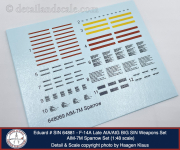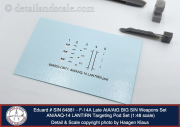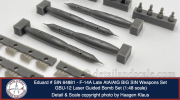Eduard BIG SIN # SIN 64881
F-14A Late AtA/AtG Weapons Set

Tamiya’s 2021 release of their 1:48 scale F-14A Tomcat (Late) Carrier Launch Set kit provides scale modelers with a lot of creative possibilities (and see our review HERE)During the last decade of the F-14’s service, Tomcats continued to employ their traditional loadout of three air-to-air missile types but were also complemented by a variety of air-to-ground munitions. For a thorough rundown of the history and details of the F-14’s ordnance and other weapon systems, we encourage you to check out Detail & Scale’s 2022 publication on the F-14 HERE. In this BIG SIN set, Eduard has bundled – at a decent savings – no less than six of their individual aftermarket sets to be paired with the Tamiya F-14A (Late), but any of these stores can be quite easily adapted to just about any 1:48 scale F-14A/B/D kit. There are both air-to-air and air-to-ground stores, abbreviated here by Eduard as “AtA and AtG.” The set (# SIN 64881: F-14A Late AtA/AtG Set) has an MSRP of $56.95.
First, a look at the air-to-air weapons:
Eduard #648029 – AIM-9M/L Sidewinder: this set contains 28 cast resin and 26 photoetched metal along with one decal sheet parts for four short-range AIM-9M/Ls. The missile bodies and fixed wings are each a single piece, which makes construction straightforward. The forward fins are separate items, but the photoetched metal parts include an alignment jig to provide just the right angles for the fins. Overall detail looks both accurate and very sharply cast. I can see no obvious warpage of the missile bodies except for a slight bit of curvature in one of the AIM-9s, but this can be easily rectified by bending the missile body back gently under some hot water. Clear resin parts are provided for the infrared seeker domes, and seeker covers are also included. The rocket motor nozzle covers and some of the missile hanger parts are photoetched metal items. Pre-painted metal remove before flight tags come in two styles (white and black lettering) but these tags are probably closer to 1:32 scale in size. One can probably still get away with using them without too much fuss. Missile markings on the decal sheet are for live Sidewinders (yellow and brown stripes) and include all the various small stencil markings.
Eduard #648069 – AIM-7M Sparrow: the four medium range AIM-7Ms amount to 20 cast resin parts, eight photoetched metal parts, and a decal sheet. Casting once again appears impeccable and captures details such as the near-conformal Sparrow’s target proximity detection antenna. The missile body and aft wings are a single piece and the mid-body-mounted fins are all separate items. Rocket motor caps are photoetched metal parts. Decals provide markings for live AIM-7s, only.
Eduard #648107 – AIM-54C Phoenix: the Phoenix was the F-14’s famous long-range air-to-air missile, and this set provides four AIM-54Cs. There are eight cast resin parts and one decal sheet. The entire forward section of the missile is a single cast part that includes the fixed forward wings and is joined to a single-piece control section with the steerable fins cast as part of the aft missile element. Detail on these missiles appears really accurate and is quite impressive. Decals are provided for markings and stencils for live AIM-54s as well as captive-carry ATM-54 training rounds (blue stripes). One interesting note: the decal sheet has different numbers for the SERNO (or serial number markings) and corrects an error in the Tamiya kit. Tamiya’s decal sheet has identical AIM-54 SERNOs for all their Phoenix rounds. In real life, each missile had different serial numbers tied to the individualized frequency each AIM-54 used to receive its unique targeting data from the F-14’s AN/AWG-9 radar.
Now, the air-to-ground items:
Eduard #648553 – AN/AAQ-14 LANTIRN Pod: the heart of the F-14’s air-to-ground capability was the AN/AAQ-25 LANTIRN Pod System (referred to as just the LTS in the Tomcat community) which provided all the sensor and targeting data for precision strike weapons. Eduard’s pod is built up out of four cast resin parts, two photoetched metal parts, and one decal sheet. The LTS was based on the AN/AAQ-14 LANTIRN pod used by the F-15E and F-16C. Just about all the differences between that and the LTS were internal, so Eduard can get away with recycling their standard AN/AAQ-14 set in this BIG SIN offering for the F-14. Note that part R50 is for the pylon adaptor for an F-16, so obviously, do not use it here. Details such as the FLIR ball turret, panels and rivets, vent grills, and the pylon hangers are well executed. The decals look great, but they do lack the prominent stenciled (and sometimes stylized) pod number often painted on the side of F-14 LTS pods. To me, that is a missed opportunity.
Eduard #648093 – Mk. 82 Bombs: some of the earliest experimentation with air-to-ground weapons in the fleet took place in 1990 with “dumb” iron bombs such as the Mk. 82. While precision-guided weapons were always favored, 500-pound Mk. 82s would still be carried by Tomcats, especially those flying reconnaissance using the TARPS pod. During Operation IRAQI FREEDOM, two VF-2 F-14Ds on one such armed TARPS sortie sank Saddam Hussein’s presidential yacht (which was relaying battlefield communications) using unguided Mk. 82s and M61 cannon fire. This set contains 30 cast resin parts and decals for six Mk. 82s. The F-14 could carry a maximum of four Mk. 82s simultaneously, so you will have a few spares. The bomb bodies plug into the aft tail units (a nice touch) and three different nose fuses are provided. However, do not use the fuse extender. To my knowledge, the extenders were neverused on any Mk. 82s hung from an F-14. This set, however, really represents USAF Mk. 82s. These bomb bodies are smooth. Navy bomb bodies had a roughened thermal protective ablative coating which is absent here. If you should use this set and seek accuracy for an F-14, I would recommend applying some Mr. Surfacer to the bomb body, and while it is still a bit wet and tacky, dab it with a paper towel to roughen up the surface. The effect is easy to accomplish and looks great.
Eduard #648155 – GBU-12: The GBU-12 was a laser guided bomb commonly used by the F-14 (not a missile, though Eduard calls it that in their instructions). This set has 30 parts and a decal sheet for four of these 500-pound bombs, with again a single-piece bomb body plugging into an aft tail section with integrally cast wings. Control fins are separate parts, and two styles of nose fuses are present. Unfortunately, just as with the Mk. 82 bomb set, this set, represents smooth-bodied USAF GBU-12s. The ablative fire-resistant coating is absent, but the scale modeler can fix this issue as described above.
However one may choose to use the items in this impressive BIG SIN set, you will have a wide range of options and possibilities for external stores for a late-F-14A. I will also say that Eduard was smart and wisely did not include JDAMs. Some manufactures have provided satellite-guided bombs for F-14A kits, but the F-14A was neither cleared nor technically capable of employing JDAMS (though the F-14B and F-14D were). Besides the issues with the smooth bomb bodies, the only other observation I can offer is to use extra caution when cutting missile and wings/fins from their casting gates. The fins are very thin, and hence, very delicate. In sum, the combination of scope, attention to detail, and weapons diversity in this BIG SIN set will prove very valuable to any 1:48 scale late F-14A project.
We sincerely thank everyone at Eduard for the review sample. You can visit them on the web athttp://www.eduard.com and on Facebook at https://www.facebook.com/EduardCompany
Haagen Klaus
Scale Modeling News & Reviews Editor
Detail & Scale






















